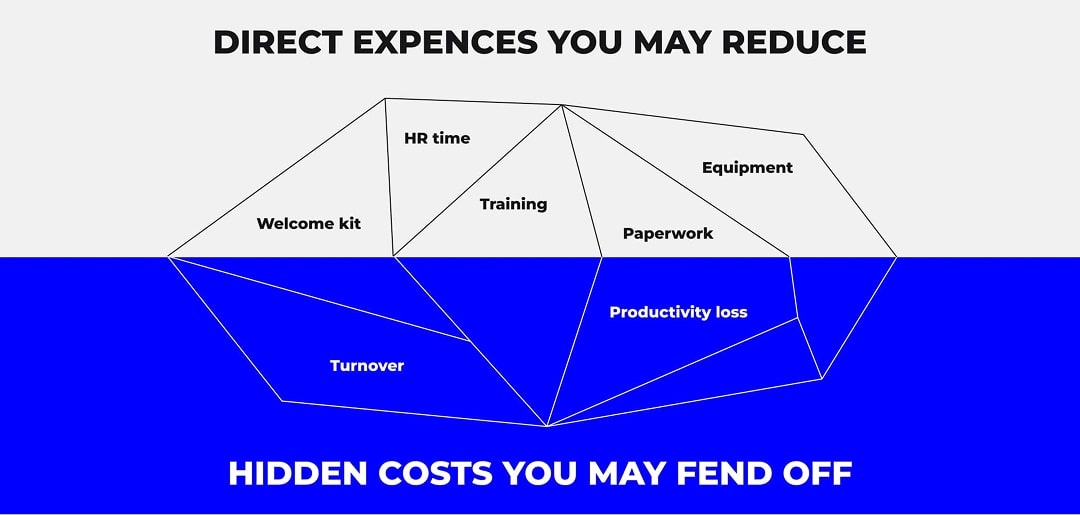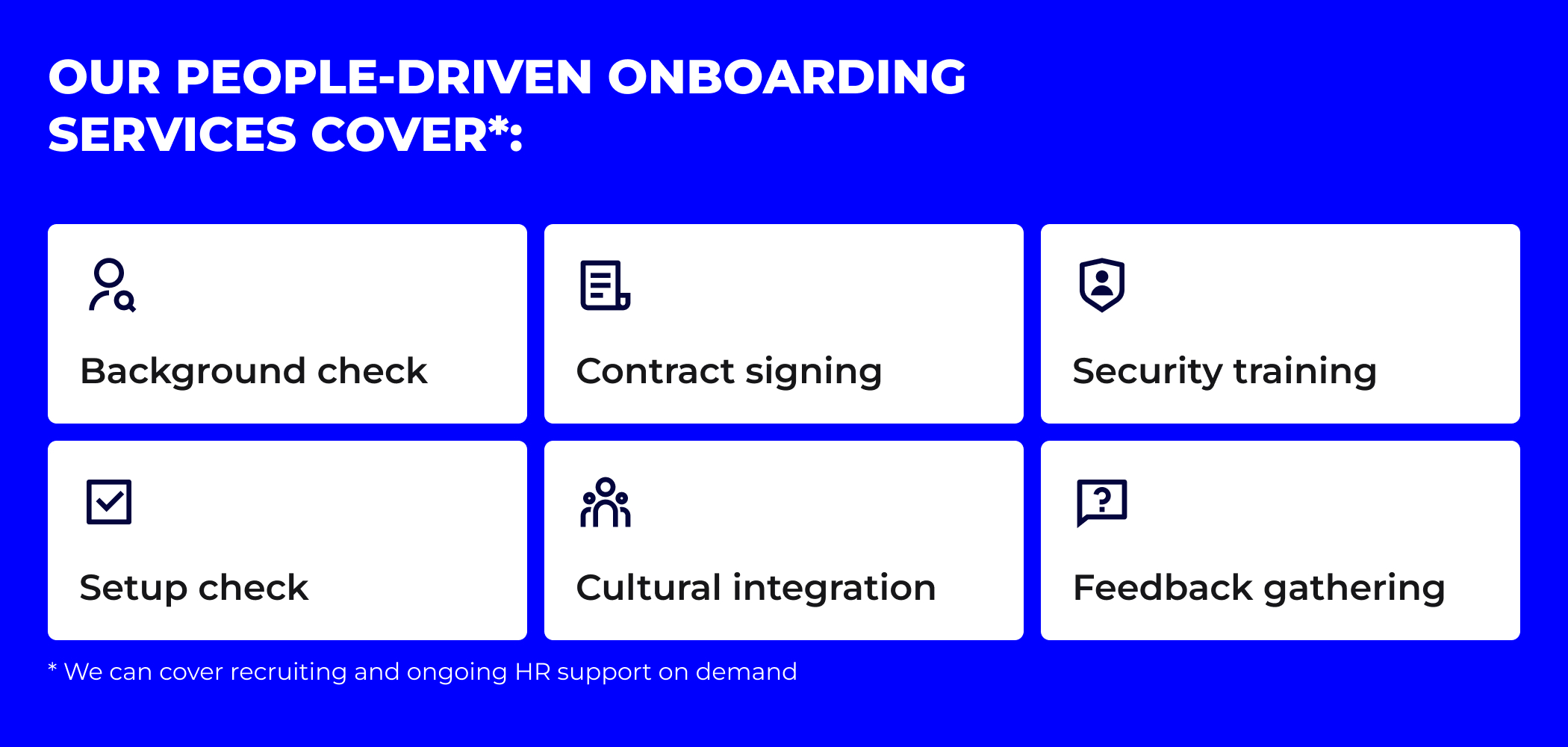Talent shortages, retention crisis in tech… Yet, tech jobs market grows unstoppably, as BLS claims. It seems like a bunch of entrepreneurs realize that hiring new tech specialists is a must to start a venture, grow a business and stay competitive. Even companies known for the massive lay-offs increase their hires within tech teams, especially those engaged into AI development.
Another question is how to turn a cost of a new hire into a profitable investment rather than an unaffordable (or bank-breaking) luxury.
The key metrics for planning and optimizing HR budgets are an average cost to hire, a cost to recruit (all expenses from job advertising to recruitment) and a cost to onboard a new employee. The last one is under our purview today, as many companies find it difficult to measure the onboarding effectiveness.
What Is the Cost of Onboarding New Employees?
An employee onboarding cost is associated with HR time spent to help a new hire settle into their role. To see the bigger picture, I strongly recommend you take into account the cost of equipment like laptops, training resources, time needed to reach full productivity, and other factors listed below.

Onboarding Cost: Calculation Checklist
To estimate the real cost of onboarding a new employee to your team, you can add all the expenses within all the related categories.
✔️ HR time cost = onboarding specialist's hour rate × the number of onboarding hours.
✔️ Cost of training new employees depends on the cost of the mentor’s time, training materials or courses.
✔️ Training compensation and benefits are payments your newcomers get during initial orientation, job-specific training, and probationary periods.
Reduce onboarding costs by 30% and streamline business ops with our professional staffing services
Grasp all benefits
✔️ Take into account any hardware, software, or tools needed for the new employee to perform their job effectively, such as computers, software licenses, mobile devices, and specialized equipment.
✔️ Administrative expenses associated with paperwork, completing documentation, processing payroll, setting up benefits, are about $400 per one new team member on average for small and mid-sized businesses in the industry.
✔️ Supervision and Mentorship. Time and resources allocated for supervising and mentoring the new employee, including meetings, check-ins, and guidance provided by managers or senior team members.
✔️ Lost Productivity. The productivity loss experienced by the new employee during the initial learning curve and adjustment period, as well as any decrease in productivity among existing team members who may need to assist or train the new hire.
✔️ Potential Turnover Costs. If the newcomers do not work out and leave a company shortly after being hired, there may be an additional cost of onboarding new employees associated with a replacement.
What Increases Onboarding Cost?
Typical onboarding costs range from a few hundred dollars to tens of thousands per employee, depending on the specific circumstances.
The key factors increasing a cost of onboarding new employees are:
Complex onboarding process. The company size and organizational structure: larger companies with more complex onboarding processes tend to have higher onboarding costs per employee.
Blurred areas of responsibility. Companies with clearly defined HR roles and responsibilities and documented procedures can save up to 50% on onboarding costs.
The onboarding format. In-person onboarding has additional costs for things like workspace setup and travel, while remote onboarding can be more cost-effective.
The specialist's experience level. Onboarding a senior-level pro with specialized skills typically takes longer and costs more than onboarding an entry-level hire.
The number of people involved. Beyond just HR and the new hire's manager, onboarding often involves time of IT, finance, security, and other teams, all of which adds to the cost of onboarding.
The time to productivity. It can take anywhere from 2 weeks to 12 months for a new employee to become fully productive, and this lost productivity represents a significant onboarding cost.
Cost Optimization Strategies
I believe that saving on employee onboarding costs, like the HR cost optimization in general, doesn't necessarily mean cutting corners. Maybe, you will be surprised to know that nearly every third specialist quits in the first 3 months because of confusing start at a new place. Statistically, an average cost of onboarding a new employee is about 6x less than the cost of their offboarding in case of mis-hire. By saving an extra cent at the start, you may miss some onboarding focuses and lose thousands of dollars in the future.
A much more forward-looking strategy to optimize a cost of onboarding a new employee without compromising quality would be sticking to the proven onboarding success factors. The main of them are crafting a linear roadmap, reducing first-day stress, and being open in terms of company plans.
100% Working Ways to Decrease the Cost of Onboarding
Centralize Information. Use an employee portal or intranet to provide easy access to company policies, training materials, and FAQs. This saves time on repetitive explanations.
Automate scheduling training sessions, sending welcome emails, and managing paperwork.
Utilize Online Training Platforms. These platforms are often more cost-effective than traditional classroom training, and employees can complete them at their own pace, reducing the need for dedicated trainers.
Assign Buddies to Newcomers. 56% of new hires admitted that having an onboarding buddy accelerated their adaptation speed.
Gather Feedback from new hires with the help of Google Forms, for instance. Analyze onboarding experience to make the onboarding process even better over time, reducing the need for costly revisions later on.
Develop a standardized onboarding checklist that covers all the necessary steps. This makes sure nothing is being missed and departments stay on the same page.
Consider using VDI (virtual desktop infrastructure) or DaaS (Desktop as a Service). With such a solution, you don’t need to:
Provide powerful equipment to newcomers, as your team members can use the capacity of your company’s on-premise or cloud server;
Allocate a bunch of time to set up new working environments, as virtual desktops are standardized and pretty easy to deploy.
Outsource Non-Core Activities. A recent survey by Gartner on human resources reveals that 77% of people now value support from their managers more than before. However, managers find themselves burdened with 51% more tasks than they can handle efficiently.
Certain aspects of onboarding, such as background checks, paper signing, and further milestone talks, can be handled more efficiently by HR professionals. To mitigate any risks, consider tech teams onboarding services with proven track record and security certifications.

Strategies With Potential Caveats
On one hand, managing organizational culture becomes harder when a business scales. On the other hand, I’d opt for keeping the same level of personalized approach to all team members throughout the business life cycle, whether it’s a startup or global corporation.
In this light, many HR teams, including our team, are careful with cookie-cutter solutions. I am to provide a couple of examples for you.
Cross-Training. You can save time and conduct a group training for newcomers on basic tasks that are common across roles. Yet, one-to-ones are a chance to take a closer look at your hires and ensure they feel comfortable all over the onboarding. Doubled attention during the first days brings more loyalty in the long run.
Onboarding virtual assistant. You can provide your team with 24/7 HR support and delegate answering some FAQs to chatbots. But in case a specialist doesn’t understand a robotic explanation, they should have an opportunity to contact a competent human. The tool designed to save time can act vice versa then.
According to my experience, the most time-consuming questions are those related to terms of agreement. At the same time, they are the most difficult for virtual helpers to deal with. What a vicious circle!
Implementation of an HR Chatbot or some VR onboarding solution is a pretty expensive endeavor, as there are no 2 twin companies in the world. As well as each CRM or ERP should be tailored to a business, HR software should be developed exclusively for a certain team. To make those investments pay off, you should be confident that they are reasonable for your team size, and you have a professional HR team to handle HR tech.
You can approve or decline any other strategy by asking if it is focused on integrating new hires into company culture and workflows first? There should be a fine line between cost-effectiveness and quality of onboarding. By keeping this balance, we grow our clients’ teams retention up to 82%. Drop us a line to learn how we can help you build reliable teams even in the times of crisis.
FAQ
What is standard onboarding?
As onboarding is the crucial process of familiarizing new employees with a company, it should be structured and treated like a valuable business operation. Onboarding programs may differ for various team roles and teams, yet it’s better to have onboarding plans for all the cases ready beforehand and stick to those plans step by step, like sticking to a standard. During an onboarding, new hires typically 1) sign all the necessary papers; 2) study relevant security rules; 3) by studying SOPs, company policies and knowledge bases, acquire the knowledge, skills, and behaviors needed to grasp their roles and responsibilities. A well-performed onboarding is a hiring stage through which newcomers integrate into an organization with ease. So, we’d recommend you improve your onboarding programs over time by analyzing team dynamics and feedback from hires.
What is the difference between hiring and onboarding?
Hiring is about picking the right person for a job, like arranging interviews and making a job offer. Onboarding is about helping the new person adapt to their new job and company. This includes things like training, paperwork, and making sure they know what to do.
What does HR do in onboarding?
A Human Resources Specialist handles paperwork for pay, benefits, wellness, rules, policies, and new hires. They may also manage orientation and onboarding resources, as well as assist newcomers with the onboarding steps one by one. When you opt for our onboarding services, you get all the Administrative and People Ops covered by our HR team.
Ann Kuss is the CEO at Outstaff Your Team. After 11 years of expertise in building remote tech teams for startup unicorns and global tech brands, Ann decided to lead a new venture aiming to reinvent the way international tech teams scale. Throughout her career, Ann hired specialists for countless tech positions from more than 17 countries on all major continents. Ann graduated from Kyiv-Mohyla business school, is an MIM Kyiv alumna, and regularly takes part in mentorship programs for junior tech talents. Ann actively promotes knowledge sharing and curates Outstaff Your Team blog strategy, preferring topics that solve practical needs of IT leaders. She believes that structuring business flows (including hiring) is a well-planned journey with predictable and successful outcome.



